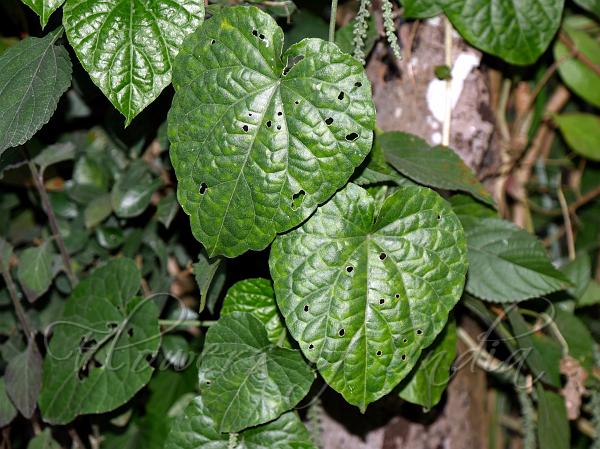|
| Climbing Rough-Leaf |
|

|

| File size | 1008220 |
| Original date | 1/13/24 4:37 PM |
| Resolution | 4592 x 3448 |
| Flash | Flash fired |
| Focal length | 61.0mm |
| Exposure time | 1/60s |
| Aperture | 5.2 |
| Focus Distance | |
| Metering Mode | Multi-segment |
| Camera make | Panasonic |
| Camera model | DMC-G85 |
| Sensor type | OneChipColorArea |
|
|
|
|
Photo: |
Botanical name: Natsiatum herpeticum Family: Icacinaceae (Unicorn Plant family)
Synonyms: Sicyos pentandrus, Natsiatum tonkinense
Synonyms: Sicyos pentandrus, Natsiatum tonkinense
Climbing Rough-Leaf is a climbing shrubs, with young
branches yellow-brown bristly; old branches prominently warty. Leaves
are simple, alternate, spiral; leaf-stalks about 3.5-7.5 cm, slender,
yellow-brown crispate velvet-hairy; blade about 8-15 x 5-10 cm, broadly
ovate, heart-shaped to flat or abruptly wedge-shaped at base, pointed
or tapering at tip, toothed, papery, rough due to stiff, white hairs;
secondary nerves 3-5 pairs, midrib prominent below, concave above,
tertiary veins subparallel, netveined veins prominent. Flowers are
borne in leaf-axils, in hairy spike-like racemes, about 10-12 cm long,
slender, drooping. Flowers are unisexual; bracts linear; flower-stalks
about 2-3 mm long; sepals valvate, linear-lanceshaped, outer surface
densely covered with coarse hairs. Petals are 5, about 2.5 mm long,
lanceshaped, hairy inside. Male flowers: filaments short; anthers arrow
shaped; Female flowers: staminodes subulate; ovary hairy; style
2-3-lobed, laterally compressed, ovate, rugose. Fruit is about 1.5 x 1
cm, yellow-green, becoming black with age. In Assam, The leaves and tender shoots are eaten by the Miris, cooked as a pot herb, especially with fish.
Climbing Rough-Leaf is found in NE India, Eastern
Himalaya, Eastern Ghats and parts of SE Asia, at altitudes upto 2400 m.
| Identification credit: Niku Das | Photographed in Monabari T.E., Biswanath, Assam. |
• Is this flower misidentified? If yes,